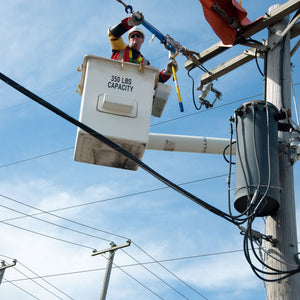Lug-All: The Evolving Nature of Safety

Everyone knows that working on electrical power lines can be a dangerous task. For workers who build and maintain the national power grid, the dangers of high voltage, heights, toxic chemicals, fire hazards, and extreme temperatures are a common part of the job. Since the first electric utility service was created, improvements in worker safety have done much to mitigate those risks. However, as electrical services continued to expand, and as the industry continues to change today, the risks facing electrical workers have also changed and expanded.
New technologies and changes in electricity generation, transmission, and distribution create new safety hazards, which require new solutions. Utility companies are transitioning toward more renewable energy sources, as well as upgrading infrastructure. These upgrades are aimed at more efficient generation, transmission, and distribution to reduce costs to customers as well as the overall footprint of the grid. These upgrades to efficiency also create new considerations when it comes to worker safety.
Equipment
To protect against new hazards, electrical workers require new safety measures. New safety measures can include both personal protective equipment (PPE) and tools. PPE that has been sufficient in the past may not provide the necessary protection against the risks of a more efficient electrical grid. Now, many manufacturers are producing PPE that is designed to protect against multiple hazards at once, such as equipment that protects against both arc flash and flash fire.
Other innovations in PPE include the integration of modern technologies into existing equipment—what you might call smart PPE. Some manufacturers have begun providing PPE with RFID tags that allow the equipment to be catalogued digitally. This RFID technology can help ensure that the PPE is properly tested and certified before a worker uses it. It can also be used to ensure that workers use the PPE with the correct safety requirements for a specific task by providing easy access to information on the material, manufacture date, equipment class, testing and certification dates, and more.
Tools
As with everything, it is important to have the right tools to perform linework safely. Just as manufacturers release new PPE, tool manufacturers also continue to create improved tools and other equipment. New tools may be lighter or designed for multiple tasks to reduce the amount of weight line workers must carry when climbing. Tools might also be designed for more precise applications, so that workers don’t have to improvise solutions, which can lead to unsafe work practices.
Additionally, custom options for tools can allow workers to approach their specific tasks in the safest, most efficient ways possible. Unlike one-size-fits-all solutions, customized equipment can be tailored to workers’ specific needs, which can also help eliminate improvised solutions.
As technology continues to progress and electrical infrastructure is modernized, safety for line workers needs to keep up. As workers’ safety needs change, tools and equipment need to change with them.
